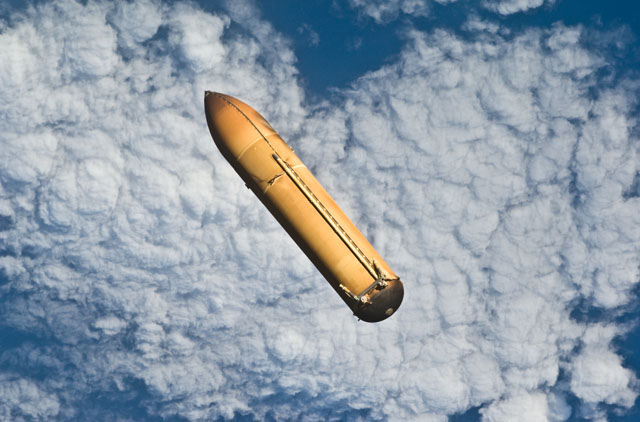
On the 35th anniversary of the first space shuttle launch, the last remaining external fuel tank set sail today from its factory in New Orleans to Los Angeles and a remarkable museum attraction in the making.
Known as External Tank No. 94, the relic of a bygone era departed NASA’s Michoud Assembly Facility where Lockheed Martin technicians had built the 65,000-pound structure in 2000 for use on a space shuttle mission.
But the tank never flew, instead serving as an investigation tool and giving up insulating foam samples for dissection in the wake of the Columbia accident in 2003.
NASA did not have the tank restored to flight status, in part because it was manufactured to older weight specifications that made it heavier than the tanks that flew the final shuttle flights.
Now, it is headed to the California Science Center, home of the retired orbiter Endeavour, to become part of an exhibit that will display the full shuttle stack in the vertical just as it was on the launch pad.
External tanks — 28 feet in diameter and 154 feet long — were the structural backbone of the shuttle vehicle on launch, holding the twin solid rockets while being the reservoir of a half-million gallons of liquid hydrogen and liquid oxygen for the orbiter main engines. The tanks were the only expendable part of the shuttle system, separating from the orbiters while on suborbital trajectories and burning up in the atmosphere on the way back down.

“With the transfer of ET-94 from NASA, we will have the ability to preserve and display an entire stack of flight hardware, making the Samuel Oschin Air and Space Center an even more compelling educational experience,” said California Science Center President Jeffrey Rudolph.
“With the same outpouring of community support we saw with the arrival of Endeavour, we look forward to celebrating this gift from NASA as it journeys from the coast through city streets to the California Science Center.”
The month-long journey by sea that began today will take the tank-carrying barge through Panama Canal and around to Marina del Rey, California. Officials say the trip will hug the coastline and would come ashore if bad weather threatens during the trip. Arrival is targeted for May 19.
On Saturday, May 21, the tank will travel the Los Angeles city streets from the marina dock to Exposition Park in 13 to 18 hours, parading a distance of 16 miles.
It will be reminiscent of Endeavour’s 12-mile trek from the Los Angeles International Airport to the museum in October 2012, albeit less disruptive to utilities and no trees will need to be cut down this time given the tank’s smaller width.
“Nearly 1.5 million people came out to cheer Endeavour, bringing joy to everyone, young and old. The event celebrated our sense of wonderment and community pride,” said Inglewood Mayor James Butts.
Endeavour has been on display, horizontally, to the public since October 2012. Admission to the Samuel Oschin Space Shuttle Endeavour Pavilion is free, with a shuttle main engine, fuel cell and Endeavour’s galley and toilet among the other artifacts to see up close year-round.
The tank will go on immediate display as well, residing on the north side of the pavilion for the public to see. Restoration crews will be busy re-installing the orbiter attachment hardware to the exterior of the tank and repairing the areas of foam removed by the Columbia Accident Investigation Board and around the intertank flanges that NASA had removed for other engineering tests.
The museum will break ground later this year for the permanent home of the vertical Endeavour attraction — the Samuel Oschin Air and Space Center. Officials are working to raise the $250 million through gifts and pledges to fund the project.
The center will have three halls — air, space and shuttle — to host a variety of artifacts, aircraft and spacecraft. The current CSC museum already houses three space capsules — Mercury 2 that launched the chimpanzee named Ham in 1961, Gemini 11 flown by Pete Conrad and Dick Gordon in 1966 and the U.S. command module from the 1975 Apollo-Soyuz Test Project that featured the first handshakes in space between Americans and the Soviets.
About 24 months after construction begins, Endeavour will be moved from the pavilion to her new home a short distance away on the museum campus, be hoisted upright and then mated to the tank and boosters. The 188,000-square-foot facility should open in 2019.
California Science Center has a pair of solid rocket boosters acquired from the Kennedy Space Center Visitor Complex. They are light-weight filament-wound cases built for polar-orbit space shuttle launches from Vandenberg Air Force Base in California, a project cancelled after Challenger.
The boosters had been displayed in Florida as part of an outdoor shuttle exhibit with a pretend orbiter and external tank mockup. That shuttle has since moved to the Shuttle Carrier Aircraft attraction at the Johnson Space Center’s Space Center Houston.
The boosters were trucked in California in the summer of 2012 and remain in storage at NASA’s Dryden Flight Research Center.

California Science Center is located in Exposition Park next to the LA Memorial Coliseum, where the University of Southern California plays college football, the Los Angeles Rams will play home NFL games next season and site of the 1984 Summer Olympics. CSC is between the Natural History Museum of Los Angeles County and the California African American Museum and just west of the 110 Harbor Freeway. It is a mere two miles from the Staples Center.
See our coverage of Endeavour’s final spaceflight and retirement archive.



